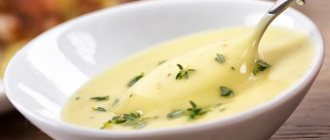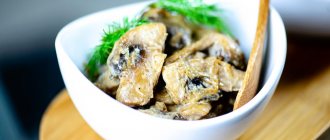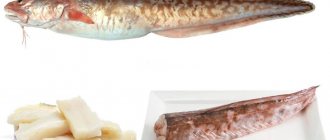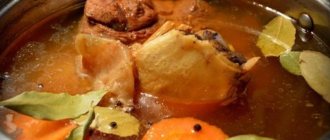Rassolnik with beef tongue
Beef or veal tongue is one of the most valuable offal and is even considered a gourmet product - it is perfectly absorbed by the body, has a delicate taste, and contains many nutrients.
It is known that beef tongue can normalize digestion, since this product contains a very small amount of connective tissue. The weight of beef tongue can range from 0.2 kg to 2.5 kg depending on the size of the animal.
Beef tongue is one continuous muscle that has a rough shell.
This product can be prepared and served as an independent dish, or as an ingredient in salads, cold and hot dishes. Beef tongue is used in various cuisines around the world.
In addition, beef tongue has long been quite actively used by the food industry in the production of a variety of sausages, ham, various smoked meats and canned meat. It is also known that beef tongue meat goes well with many seasonings.
The usefulness of beef tongue is explained by its rich chemical composition.
Of course, water takes up a considerable amount of beef tongue - about 70%, but water always remains the main component of all living organisms, so this is not surprising.
Proteins make up 13% of the tongue, and the same amount (13%) of beef tongue contains fat. However, there are very few carbohydrates in this large muscle - about 2%. Beef tongue meat contains various extractive substances, that is, those substances of organic origin that pass from the meat into the broth during the cooking process.
Extractives include, among others, urea, tyrosine, creatine, creatinine, leucine, taurine, xanthine, as well as inosinic acid and glutamic acid and some other substances. In addition, beef tongue contains vitamins, especially a lot of B vitamins (B1, B2, B3, B6, B12) and vitamin E.
The calorie content of this product (beef tongue) is relatively low - only about 173 kcal per 100 g of product.
Most modern people are concerned not only with the calorie content of a product, but also with its cholesterol content. As for the amount of cholesterol in beef tongue, it can be considered minimal and does not exceed the level of 150 mg per 100 grams of product, and this allows beef tongue to be included in the list of dietary products. But still, beef tongue, which has already been cooked (for example, boiled), is somewhat higher in calories and contains 231 kcal per 100 g of product.
Just one hundred grams of beef tongue can satisfy almost a tenth (9%) of the daily calorie requirement, that is, the required energy. The same amount fully satisfies the body’s need for vitamin B12 during the day. In addition, beef tongue normalizes carbohydrate and fat metabolism (metabolism).
The same 100-gram portion of beef tongue provides 40% of the body’s daily requirement for zinc.
It is known that the presence of beef tongue in the menu reduces cholesterol levels, while the skin receives additional opportunities for regeneration and renewal.
Zinc, which is contained in beef tongue, promotes faster and better healing of wounds and improves the overall condition of the skin.
A very impressive amount of B vitamins in beef tongue has a positive effect on the condition of not only the skin, but also the hair, which becomes more vibrant, silky and shiny.
Vitamin PP (or B3) provides invaluable assistance to people who suffer from insomnia and/or migraines.
Boiled beef tongue is recommended for people with diseases of the gastrointestinal tract, including those with peptic ulcers of the stomach and/or duodenum, since this product is practically devoid of connective tissue and its fibers are very easily digested, without provoking the onset of putrefactive processes in the intestines.
It is also known that beef tongue is recommended by nutritionists for diseases of the heart and vascular system.
It is very important that beef tongue, if consumed regularly, helps strengthen the immune system. It is equally important that beef tongue, having a fairly high zinc content, activates the production of insulin and is therefore useful for people with diabetes.
Among other things, regularly including beef tongue in the menu maintains the required level of vitamin and mineral balance.
Like any product, beef tongue has some contraindications that should be taken into account when choosing this offal.
Like any other product, beef tongue is also characterized by individual intolerance, that is, when this product is categorically not tolerated by someone’s body. However, such intolerance is extremely rare.
Also, beef tongue is contraindicated for those people for whom meat products are contraindicated in principle, although beef tongue is absorbed and digested much easier than any other types of muscle tissue.
If any product, including beef tongue, is poorly digested, then there is a risk of increased stress on the liver and kidneys, as well as a high probability of decreased immunity. Most often, such phenomena and the inability to digest certain foods occur in elderly and very elderly people. That is why it is better for older people to avoid eating beef tongue.
It is very important to remove the hard shell from the tongue, so it is better to remove it almost immediately after boiling - often heaviness in the stomach and other unpleasant symptoms arise due to the hard shell not being removed in time.
If the tongue seems too oily (it contains 13% fat), then the volume of consumption of this product should simply be reduced, but it is not necessary to completely abandon it.
Gastroenterologists warn that people with chronic diseases of the digestive system should consume beef tongue meat with extreme caution.
Properly cooked tongue meat becomes a real delicacy - it is soft and tender.
Boiled tongue
In the home kitchen, beef tongue is most often boiled, then cooled and cut into portions. In addition to portion-cut tongue, this offal is often used to prepare aspic. Sometimes soups are prepared using the broth in which the tongue was boiled.
In order for the beef tongue to be cooked correctly and of high quality, it should be immersed in boiling water. That is, you should first put water in a saucepan of sufficient size and bring it to a boil. When the water boils well, place the beef tongue in the boiling water and cook for five minutes. After five minutes, remove the tongue from the broth, cool slightly and remove the hard skin from the tongue.
After the skin has been removed from the tongue, the product is returned to boiling water and the tongue is cooked over low heat until tender.
How long does it take to cook beef tongue? Naturally, the time depends on the size and weight of the tongue, but experience shows that the cooking time for beef tongue ranges from three to four hours.
To determine whether the beef tongue is cooked to full readiness, it should be pierced with a knife: if the knife enters the meat easily and a clear broth appears at the puncture site, then the tongue is cooked.
The finished tongue should be removed from the pan with the broth and allowed to cool. The cooled and chilled tongue is cut across the grain into thin slices and can be served as a separate dish.
In addition, the tongue, cut into small slices, can be poured with the same broth in which it was boiled (the broth should first be mixed with gelatin) and placed in the coldest place, for example, in the refrigerator, so that the aspic hardens properly. You can put slices of boiled carrots, green sprigs of parsley and lemon slices in the beef tongue aspic - to taste.
Beef tongue aspic is considered a light and healthy dietary dish.
Beef tongue can not only be boiled or made into aspic, but it can also be stewed. In order for the tongue to be stewed efficiently, it should first be boiled for five minutes, and then the tough skin should be removed from it. Then the tongue should be cut into portions and placed in a saucepan lightly greased with vegetable oil, where cream or sour cream should be added, as well as a little dry wine.
When the tongue is almost cooked, seasonings should be placed in a saucepan - this can be a variety of peppers, cloves and bay leaves.
Secret No. 1. Before cooking, the tongue should be soaked in cold water for at least half an hour, and preferably an hour. This is necessary to make it easier to clean the tongue from various contaminants. After the tongue is well soaked, it is necessary to scrape off any fat, mucus, or remaining blood from it using a knife - the skin of the tongue should remain completely clean. After thorough scraping, the tongue should be thoroughly rinsed in running cold water.
Secret No. 2. To make the tongue tender and juicy, it must be immersed only in boiling water. First, bring the water in the pan to a boil, and only then put the tongue in there, which may have to be cut in half, since it increases in size under the influence of high temperature.
When the water boils again (and the boiling stops after the tongue is placed in the pan), it is necessary to remove the foam that appears and cook the tongue for 15 minutes, after which the water must be drained. Then you need to fill the pan with clean water, put the pan on the stove again and bring the water to a boil, then put the tongue in the boiling water and cook until tender.
What to do with the broth from boiling the tongue. Is it possible to drink broth from boiling the tongue?
The first thing that common people learned to cook was soup. And then, don’t be surprised, the pots were made of leather. The nobility in medieval Europe considered soups made from offal, and especially tongue, to be a delicacy. They found its taste unforgettable and unusual.
Centuries have passed, scientists can analyze the composition of a particular product and say that tongue (beef, pork, sea, etc.) is very useful. It contains a lot of microelements. For example, magnesium with potassium, calcium with iron, copper with cobalt and others. In addition, it contains vitamins B1 with B2, B6 with PP.
The dish turns out to be nourishing, rich and very tasty. Easy to digest, not heavy on the stomach, even if you have gastritis. It normalizes the activity of the entire gastrointestinal tract. If you eat this broth-based soup regularly, you will forget about many disorders in the digestive system and will always be cheerful and full of energy. With such a charge, both mental and physical work is argued.
After we have cooked the tongue, for example, in Olivier, and the original recipe calls for using not sausage, but beef tongue, what remains is a rich broth that can be used in different ways. Pour some into a container and put it in the freezer; freezing is useful for aspic or soup with vegetables, cereals, mushrooms, and beans. From the other part prepare aromatic soup with vegetables.
Garlic imbues the dish with piquancy and original taste. Even if you just heat up beef tongue broth, add spices, herbs, squeeze out garlic, you can already have a hearty lunch. But if you are not lazy and follow our recipe to prepare vegetable soup with aromatic tongue broth, you probably won’t regret it.
How to choose the right beef tongue?
When preparing any meat dish, the main condition is that the product is of good quality. Beef tongue is no exception. When purchasing it, pay attention to the appearance, color and smell. Try to choose this product chilled for cooking. When purchasing it frozen, be sure to check the expiration date and storage conditions.
A good beef tongue has a somewhat unpleasant appearance: it is pale blue or purple in color, covered with whitish transparent skin with papillae. Moreover, the more “blue” it is, the higher the iron content it contains and the more useful it is.
Fresh tongue has the shape of a strong, elastic eggplant and a thick meaty smell. When pressed, the hole quickly disappears, and almost no liquid is released.
If the color of the tongue is pale pink and water comes out when pressed, then it has been re-frozen.
Beef tongue
Beef or veal tongue is one of the most valuable offal and is even considered a gourmet product - it is perfectly absorbed by the body, has a delicate taste, and contains many nutrients. It is known that beef tongue can normalize digestion, since this product contains a very small amount of connective tissue.
Can be served with cucumber, red beets, lettuce, cucumber, tomato. The soup has a good typical flavor and can be given noodles, or crumbles, or fried sauce, or balls.
When we give enough vegetables, it is a good jentak vegetable broth. The most famous use of beef was as a broth, which was given to patients when they recovered.
He prepared flesh and bones, especially the swamp, which his ancestors said hid great life force.
Beef tea - made from meat and vegetable dishes, served cold or warm in small cups. Nansen - cold without fat, refined with Russian vodka, served with caviar sandwiches.
- Mock turtle - with vegetables, herbs and mushrooms softened with Madeira wine.
- Minestrone - with cabbage, tomatoes, garlic, bacon and chopped spaghetti.
- Sans - with fried boiled potatoes and grains.
- Khlodnik - cold with sour cucumbers, chickpeas, eggs and ulcers.
- Provencal - with garlic, sage, pepper and fried black bread.
- Risi bis - with peas, rice and Parmesan cheese.
- Olga - with port, truffles, carrots, leeks and celery.
- Julien - with thin roots of root vegetables.
Beef is used from steak to mince in sauce, depending on the imagination and skill of the chef. The weight of beef tongue can range from 0.2 kg to 2.5 kg depending on the size of the animal.
Beef tongue is one continuous muscle that has a rough shell.
Attention! Beef tongue meat is often included in protein diets.
In addition, beef tongue has long been quite actively used by the food industry in the production of a variety of sausages, ham, various smoked meats and canned meat. It is also known that beef tongue meat goes well with many seasonings.
And the argument that the meat is hard and dry doesn't hold up. A properly cooked rib will always be juicy and tasty. The nature of the food must be adapted to the mass.
The younger cut front beef is a little less plump once cooked, but is tender and juicy.
Older bulls again produce a more pronounced broth, but the meat takes longer to simmer and relishing also reduces its long fibers.
The front of the beef is heavily intertwined with the skin, so it requires longer cooking at a lower temperature and frequent casting.
Every store that sells beef must display the animal's registration number and age in months.
It should also include the date and place of slaughter, the registration number of the animal's last breeding, as well as the cutting plant that processed the meat, says Eduard Kazda, the butcher's butcher.
The usefulness of beef tongue is explained by its rich chemical composition.
Source: https://MarioKomi.ru/goryachee/bulon-iz-govyazhego-yazyka.html
A few words about offal in general
When cutting any carcass, internal organs remain, as well as parts of the carcass that are considered less valuable products - these parts of the carcass are called offal.
As for nutritional value, by-products are completely unequal.
Some of them are considered quite valuable and are not inferior to meat, and sometimes even surpass it in the content of microelements and vitamins, while other by-products have lower nutritional value (some of them are used not for nutrition, but for the production of animal feed). Traditionally, by-products are divided into categories I and II depending on their taste and nutritional value.
- Category I by-products include liver, kidneys, tongues, heart, brains, beef udder, as well as beef and lamb tails (the so-called meat-and-bone tails). By-products that have the highest nutritional value include liver, kidneys, brains, and beef and veal tongues.
- Category II includes all other offal, including legs, ears, stomach and other parts of the carcass obtained during cutting.
By-products of various categories are often used to prepare sausages, aspic, canned food, pates, pie fillings and other dishes and semi-finished products.
An unusual soup of Turkish cuisine, which is suitable for those who like to experiment in the kitchen.
Ingredients:
- Lamb head – 2 pcs;
- Beef trim or tongue – 300 g;
- Garlic - half a head;
- Tomato paste – 2 tablespoons;
- Pepper and lemon to taste.
Boil the heads for half an hour. In a separate pan, scald the tongue, and then add it to the heads to cook for an hour and a half. When the meat begins to easily separate from the bones, take it out, let it cool and cut it off (the brain is also removed and cut into pieces). The broth is filtered and the meat is added again. Add pepper, garlic. Serve the soup with a squeeze of lemon.
How to cook boiled pork tongue
We rinse the tongue under running water; there is no need to clean it. Put it in boiling water, cook for 15 minutes. Then, drain the cloudy water, pour in cold water, cook for 1.5-3 hours. Changing the water will help remove excess odor and this will help remove the skin better. You can add to the water: ground black pepper, dried basil, onion, this will add flavor to the meat. I didn’t add anything; I seasoned it with spices only after cooking.
Drain the water, fill the tongue with cold water, and let it cool.
We clean it of skin and excess fat. Cut off excess meat from the inside.
Cut into thin pieces, 0.3 mm wide.
Season with salt, ground black pepper, grease with mayonnaise and squeeze out the garlic. I did not grease some pieces with mayonnaise, as it is not healthy for children.
Tips on how to cook pork tongue
1. Before cooking, it is advisable to soak the tongue in cold water for 1-2 hours, this will make the skin easier to clean and the meat will be more tender. 2. The offal should be cleaned only after cooking. 3. It is better to cook over low heat, with the lid on. If you allow it to boil too much, it can negatively affect its taste. Mostly I cook it for 2 hours. 4. They say that it is better not to add salt when cooking, but only spices. You can add any seasonings to your taste: ground black pepper, bay leaf, basil, cumin, paprika, parsley root. They also add a head of onion or a couple of cloves of garlic. 5. In order for the skin to be easily removed, the hot tongue must be dipped in cold water; a sharp change in temperature makes it easier to clean. 6. If the skin is very difficult to remove, it means you haven’t finished cooking it. 7. Remove the skin using a knife. Make a cut and pull the skin; if it is difficult to remove, you can cut it off in a thin layer. 8. It can be served as an appetizer or with a side dish. Perfect for a side dish: mashed potatoes, stewed vegetables, cereals. So, you have learned all the secrets: how to cook boiled pork tongue. I hope you find this recipe useful and look forward to your feedback!
Pork tongue is classified as an offal, which is why it is cheaper than meat of the first category. However, in terms of beneficial properties, it is not inferior to meat, and in some ways even surpasses it. Thus, the calorie content of pork tongue is much lower than pork tenderloin, neck or other part, and the composition is no less rich. The tongue contains amino acids, vitamins, and microelements in significant quantities. The product is considered dietary. The beneficial properties and pleasant taste of pork tongue at a relatively low cost have made it one of the popular food products, and many housewives know several ways to cook pork tongue so that it is tasty, aromatic and retains its benefits.
Rice soup with tongue
A very tasty soup made from simple ingredients that can be found in any kitchen.
Ingredients:
- Tongue – 1 kg;
- Rice – 250 gr;
- Potatoes – 400 gr;
- Onion – 2 pcs;
- Salt, pepper and herbs.
Boil the tongue as you usually do. While it cooks, chop the vegetables and rinse the rice. When the tongue is cooked, take it out and peel it, and add vegetables and cereals to the broth; everything will be ready in 15 minutes. Once the tongue has cooled, you can peel it, slice it, and put it back into the rice soup.
Pork tongue aspic
- pork tongues – 1.2 kg;
- onions – 100 g;
- carrots – 100 g;
- celery root – 50 g;
- water – 2 l;
- gelatin – 25 g;
- green peas – 100 g;
- chicken eggs – 6 pcs.;
- salt, pepper - to taste.
Cooking method:
- Soak in cold water and brush the pork tongue. Boil it for 3 hours in two liters of water, adding more if necessary, with the addition of whole carrots, onions and celery. 2 hours after the start of cooking, add salt to taste.
- Hard boil chicken eggs.
- Remove the boiled tongue from the broth, place in cold water for 10 minutes, and peel.
- Strain the broth.
- Add gelatin to the broth and stir until it is completely dissolved.
- Peel the eggs and cut them into beautiful circles.
- Cut the carrots into small cubes.
- Cool the tongue, cut into cubes or strips.
- Pour a little broth into the bottom of the silicone molds and place them in the refrigerator for 10 minutes.
- Place an egg in each mold.
- Mix tongue, green peas and carrots. Divide this mixture into molds.
- Fill with broth to the brim.
- Place the molds with the aspic in the cold for 6 hours.
- Carefully remove the aspic from the molds and place on plates.
Jellied pork tongue will decorate the holiday table, but nothing prevents you from making this dish on weekdays to please family members with a delicious dinner.
Noodle soup with tongue
This soup is quite high in calories, but so tasty that you will prefer to forget about the diet.
Ingredients:
- Tongue – 1 piece;
- Potatoes – 400 gr;
- Onions, carrots – 1 piece;
- Noodles – approximately 13 packs;
- Pepper and salt.
Cook the broth until the tongue is cooked, then remove it and let cool. Place the chopped vegetables in the pan and simmer until the potatoes are almost ready. Add noodles and cook. The soup can be served with diced tongue.
Preparation
Cooking time: 2.5 hours. Makes 4-6 servings.
- Rinse the beef tongue thoroughly under running cold water. Then clean it. Rinse and place in a pan of cold water. Cook for at least 2 hours. When it boils, do not forget to remove the foam. Strain the finished broth using a sieve. Then bring the broth back to a boil to add the vegetables.
- Peel the potatoes and cut into cubes or medium-thick cubes. Place it in a boiling brew and let it sit there for 10 minutes.
- Peel the carrots, carefully cut them into cubes or circles or halves about 3-5 mm thick and throw them into the broth.
- Remove the skins from the onion and cut it into medium cubes. It turns out beautifully in half rings of medium thickness. Throw the onions into the boiling carrots and potatoes and let them cook for 10 minutes. will leave.
- When the carrots are ready, add green beans and broccoli or cauliflower to the vegetables. Many housewives know that you can buy mixed vegetables in the supermarket. If you want, add it to the soup. But fresh vegetables are, of course, healthier.
- Turn the heat to low and simmer the soup for about 7 minutes.
- Finely chop a bunch of parsley or dill. Add chopped garlic here. Place everything in a saucepan, let it boil, and turn off.
A fragrant and healthy vegetable soup with healthy beef tongue broth is ready. Try it!
Okroshka with tongue
Okroshka is a great option for a hot summer day.
Ingredients:
- Kvass – 1 l;
- Beef tongue – 100-200 g;
- Pork ham – 100 g;
- Beef – 100 gr;
- Cucumbers – 3-4 medium;
- Eggs – 2-3 chicken;
- Add salt, sour cream, mustard, green onions and pepper at your discretion.
The yolks of boiled eggs are ground with mustard and diluted in kvass. Chop vegetables, meat and egg whites and pour into a saucepan with kvass.
Borscht with tongue and prunes
Classic “green” borscht, only with dietary tongue instead of meat.
Ingredients:
- Turkey – 1 leg;
- Beef tongue – 1 piece;
- Onions, carrots – 1 piece;
- Potatoes – 5-6 pcs;
- Eggs – 2-3 pcs;
- Sorrel – 300 gr;
- Salt, herbs and pepper to taste.
Cook broth from turkey and tongue with onions and carrots. Chop the potatoes and boiled eggs, wash the sorrel, cut off the stems and chop the leaves, but not very finely. When the meat is cooked, remove it, cut it and return it to the broth along with the potatoes. When the potatoes are ready, add eggs and sorrel to the soup. In ten minutes the borscht will be ready.
An unusual taste that the whole family will surely enjoy.
Ingredients:
- Tongue – 1 piece;
- Broth – 2.5 l;
- Beets – 3 pcs;
- Tomatoes – 3 pcs;
- Cabbage – 1 kg;
- Carrots, onions – 1 piece;
- Garlic – 3 cloves;
- Prunes – 130 gr;
- Spices and seasonings (bay leaf, pepper and salt) to taste.
Simmer the grated beets with peeled and chopped tomatoes in olive oil along with 300 ml of broth. Add grated carrots and chopped cabbage with onions to the remaining broth (boil it). Add spices. Then add chopped tongue and prunes to the soup. A couple of minutes before the soup is ready, add crushed garlic. Can be served with herbs, sour cream and lemon.
Beef tongue soups: the best and fastest recipes
Beef tongue is a delicious product with healing properties for human health. It is he who holds the lead in the content of iron, zinc and B vitamins.
Iron is essential for maintaining immunity; its deficiency causes anemia. Zinc is the main performer of the regenerative and reproductive functions of the human body.
And B vitamins are essential if you want to have a healthy nervous system.
Beef tongue has such a unique, amazing and delicate taste that it does not need to be improved, just boil it. As a result, you will get a juicy, dietary, low-calorie dish, similar in consistency to soft pate.
Recipes for soups with tongue broth
Many housewives make the mistake of being wasteful by not using the broth in which the beef tongue was cooked. But on its basis you can prepare an excellent, easy-to-digest first course. We offer you recipes for soups made from beef tongue broth:
- Broth with noodles and egg.
- Beef tongue soup with vegetables and herbs.
- Vegetable soup with meatballs.
How to boil beef tongue broth?
To prepare beef tongue soup, the main thing is to boil the broth correctly. Then the soup will turn out both tasty and healthy.
- Rinse the beef tongue under running cold water. Scrub the entire surface well with a knife or the abrasive side of a sponge, remove the salivary glands. There is no need to clean the skin off your tongue!
- Soak your tongue in cold water for 1.5-2 hours. This is done so that the thick, rough shell gets wet, and the tongue cooks faster and becomes softer.
- Rinse the soaked tongue and immerse it in a pan of cold water. The water should just cover it. Don't add salt. Bring to a boil and drain the water.
- Fill the tongue to the edges of the pan with hot boiled water, bring to a boil, add a little salt and transfer to low heat.
- Cook the tongue over low heat, covered, for 2 to 4 hours, depending on its size and weight.
You can check the readiness with a fork or a thin knife: the device should go in “like butter.” The shell of a well-cooked tongue is white and dense.
Cool the contents of the pan to room temperature, remove the tongue and peel it immediately so that the shell does not dry out.
If the broth is too rich, you can add a small amount of boiled water. Now let’s move on to the recipes for beef tongue soups with photos.
Broth with noodles and egg
Prepare for 2-2.5 liters of broth:
- 500 g egg noodles;
- 3-4 boiled eggs (quail or chicken);
- 1 teaspoon of universal soup seasoning;
- two tbsp. spoons of dry mixture of onions and carrots;
- greens, salt, pepper to taste.
Boil the broth, add salt and seasoning and dried vegetables. Discard the noodles and cook until done. Finely chop the greens (you can use dill, parsley, cilantro, green onions).
Pour the broth with noodles into serving bowls, place the boiled egg halves on the noodles, submerging them shallowly in the broth, and sprinkle with herbs.
Add a grinder of black peppercorns to your table setting.
Soup with vegetables and herbs
We offer an original recipe for beef tongue soup with vegetables and herbs.
Ingredients:
- 150-200 g of boiled tongue;
- 2-3 potatoes;
- 1 onion;
- 1 carrot;
- any dried herbs: oregano, celery, basil, thyme, rosemary, marjoram or a ready-made dry mixture of herbs;
- salt, pepper to taste.
Cut fresh vegetables into cubes and boil. 10-15 minutes before readiness, throw in the beef tongue cut into strips, add dried herbs to taste and simmer under the lid over low heat.
Serve the soup to the table in a large deep tureen and pour it into plates when the diners are already seated. Thus, the thick, appetizing aroma of herbs and broth “spirit” will rise above the dinner table.
Serve with rye bread croutons.
Vegetable soup with meatballs
If you want to serve soup with meat, but don’t want to use beef tongue, we offer you the option of a quick vegetable soup with meatballs.
For this beef tongue soup you will need:
- 200-300 g minced meat;
- frozen vegetables: green peas, green beans, broccoli, cauliflower, bell pepper;
- 2-3 potatoes;
- leek;
- salt, pepper to taste.
Roll the minced meat into meatballs, roll in flour and lower into boiling broth. As soon as the meatballs float, throw in the frozen vegetables and diced potatoes. Cook everything until done, stirring slightly so as not to damage the meatballs.
Chop the leek into small chips and masher until the juice releases. When the soup is cooked, pour the onion into the pan and leave everything to brew for 15-20 minutes.
Tip: Make meatballs from minced chicken - the soup will be easier for digestion. To prevent the meatballs from boiling, break a chicken egg into the minced meat.
Source: https://FB.ru/article/450624/supyi-iz-govyajego-yazyika-samyie-luchshie-i-byistryie-retseptyi
Horseradish and tongue soup
A completely non-spicy soup that will delight you with a combination of horseradish, celery and the taste of beef tongue.
Ingredients:
- Tongue – 300 gr;
- Tongue or beef broth – 1.5 l;
- Carrots, onions – 1 piece;
- Potatoes – 2 pcs;
- Celery root – 14 roots;
- Horseradish root – 1 piece;
- Sour cream – 250 ml;
- Spices to taste.
Stew chopped celery, carrots and onions in a saucepan or deep saucepan; when the carrots become soft, add the potatoes, and then pour the broth into the pan. When everything is cooked, add chopped tongue, grated horseradish root and sour cream to the soup. The soup will steep for about five minutes, after which it can be poured into plates.
Pork tongue casserole
- boiled pork tongue – 0.6 kg;
- boiled potatoes – 1 kg;
- onions – 0.3 kg;
- mayonnaise – 0.2 l;
- vegetable oil - as much as needed;
- cheese – 100 g.
Cooking method:
- Boil the tongue, peel it, cut it into thin slices.
- Peel the boiled potatoes in their skins and cut them into circles.
- Cut the onion into rings or half rings, depending on the size of the onions.
- Grease a baking tray with oil. Place onions on it, then potatoes. Place tongue slices on potatoes.
- Lubricate your tongue with mayonnaise.
- Grate the cheese and sprinkle it over the workpiece.
- Preheat the oven to 200 degrees, place a baking sheet in it for 15 minutes.
Tongue casserole is a complete dish. There is no need to prepare any additional side dish for it.
Pork tongue, if cooked correctly, turns out tender, juicy, and aromatic. It is delicious on its own, but is often used as an ingredient to prepare delicious and satisfying dishes. Many of the tongue-based snacks are so appetizing and pleasant to the taste that it is not a shame to put them on the holiday table. The main task is to boil the tongue. Then cooking it will be easy and pleasant.
One of the most delicious offal - pork tongue - has a small mass, approximately two hundred to three hundred grams. In addition, differing, for example, from beef, it is much more tender. Since the pig does not have to chew the cud, its tongue is not rigid and muscular.
Therefore, it cooks much faster. It makes excellent dietary dishes with amazing taste and aroma. There are differing opinions about the complexity and duration of cooking this offal. There are various options for preparing it, which will shed light on how long to cook the pork tongue until done:
- The first option:
the tongue, cleared of blood, muscle membrane, fat (if purchased at the market - needs preparation, from the store - ready for cooking after thawing), must be scraped off with a stiff brush. Then rinse with cold water, rub with lemon to improve the aroma, and place in a saucepan with boiling water. Cook with salt and seasonings over low heat, avoiding boiling. In terms of time, this will take at least an hour (for an organ of a young animal), a maximum of three hours (when the animal is old), if the amount of product is 250–400 grams. - Second option:
cook in the “second broth”. Place the prepared tongue in boiling water; when it boils again, cook for fifteen minutes, then drain the water completely. Rinse with cold running water. Then pour boiling water with spices, bay leaf, garlic and onion. This will help reduce cholesterol, remove foreign odors, and also add juiciness and flavor. Cook until desired softness is achieved. Check readiness with a fork: if it goes in easily, clear juice comes out, the center is pink, which means the pulp is ready. - Third option:
beautiful boiled tongue. It is prepared first, as usual, but after boiling and peeling, it is again sent into the broth, placed under a little pressure. In this form it should cool completely. This secret method is already known to many specialists. Thanks to him, cutting becomes perfect. - Fourth option:
very gentle. Cook the pork tongue in the same way as in the first option, but you don’t need to put salt and seasonings there first. When the dish is almost ready, peeled, the offal is again immersed in the broth, where all the spices and salt are added. Continue cooking for another twenty minutes to get a delicious and tender delicacy.
Advice: it is better to buy chilled rather than frozen offal. Before boiling, the semi-finished product needs to be soaked for thirty minutes, or better yet for one to two hours, in water, the colder the better. When cooking, be sure to cover with a lid - this will save the vitamins and microelements contained in it. You need to salt the already cooked tongue. It is worth peeling after cooking, immersing it in cold water for a few minutes, then it will be much easier to do. Do not allow it to cool too much, as it will be very difficult to clean later. They begin to remove the skin from the boiled pork tongue from its base, prying it with a knife, grabbing it, and pulling it slightly. To make it convenient, the flesh is lightly cut into it. When the skin does not come off well, this is a clear sign of undercooking, which means you should continue cooking. If a salted product is purchased, it is first soaked for about ten hours and then boiled without adding salt.
conclusions
Who said offal is a poor man's food? History confirms that both emperors and great generals did not miss the opportunity to enjoy something tasty that has nothing to do with, for example, tenderloin or collar.
Of course, nightingale tongue pate is a bit too much, but we can definitely try beef tongue aspic or Chinese cabbage salad with boiled tongue.
How many salads can you make from this offal? Yes, as much as you have patience and curiosity! And there will be other dishes that will interest you...
Beef tongue, a tasty and healthy product, is quite appropriate in any kitchen and can decorate any holiday table.
Beef tongue is not only a tasty delicacy, but also an extremely healthy product. After all, it has a very rich chemical composition. In addition, this delicacy is not too high in calories, so it can be an excellent replacement for regular meat. This makes the offal in question truly unique and worthy of special attention.
When consumed in moderation, it will only benefit the body and help it get all the necessary substances: vitamins, amino acids, proteins, as well as macro- and microelements. The benefits of the product significantly outweigh the harm. Especially if you don't abuse it.
Cooking features
The process of boiling pork tongue is long but simple. Knowing the specifics of this process, even a novice cook can successfully cope with the task.
- The tongues of young piglets are considered more tender. They usually weigh 200-250 g, while the weight of an adult pig's tongue reaches 300-350 g, sometimes even 400 g.
- Experienced chefs advise purchasing fresh or chilled tongues, however, frozen offal can also be cooked deliciously. To do this, they need to be given the opportunity to thaw in natural conditions, without exposing them to sudden temperature changes. Trying to speed up the process using a microwave or warm water will negatively affect the organoleptic qualities of the finished dish.
- Before cooking, the pig's tongue must be thoroughly cleaned. To do this, soak it in cool water for an hour or two, then wash it with a brush.
- It is advisable to clean tongues after cooking. If you transfer them from boiling water to cold water immediately after finishing cooking, the skin will come off easily and you won’t have to cut it off from the meat, damaging it.
- In order for the pig's tongues to come out more juicy, they are dipped into already boiled water. If you use broth for cooking, you can pour cold water over the offal and then bring it to a boil.
- If you are preparing tongue for a child or dietary food, the first water after a 15-minute boil should be drained and the offal should be cooked in clean water. At the same time, for baby food it is boiled 30 minutes longer than usual. A similar method is used when cooking tongue for aspic and want to get a clear broth.
- You can add salt to your tongue at any stage of cooking. 30-60 minutes before the offal is ready, it is seasoned with black or allspice and bay leaf. You can also add carrots, onions or garlic to the broth. This will make the finished dish more flavorful.
- If, after cleansing, the tongue is returned to the broth and allowed to cool completely in it, it will come out even more juicy and tasty.
The calorie content of boiled pork tongue is 208 kcal per 100 g of product. This is not too little for those who are on a weight loss diet. However, they too can indulge in this delicacy in moderation.
Boiled pork tongue is usually used to make salads and sandwiches, but it can also be served as an independent snack. As a side dish you can serve beans, pea puree, green peas, boiled potatoes or mashed potatoes, vegetable stew, and fresh vegetable salad. Bechamel sauce, mustard or horseradish go well with boiled pig tongue. It also goes well with mushrooms.
Potato soup with tongue in a slow cooker
A simple and satisfying soup that you can prepare without difficulty.
Ingredients:
- Potatoes – 4 pcs;
- Tongue – 200 gr;
- Broth – 1.5 l;
- Bell pepper – 1 piece;
- Celery – 2 stalks;
- Greens - to taste;
- Salt and pepper.
Place chopped potatoes and celery into the multicooker bowl, add broth to them and turn on the “Soup” mode for 40 minutes. Chop the pepper and tongue and add to the soup being prepared. About five minutes before readiness, add herbs and salt.
Soup with Mexican mixture and tongue
An original recipe that is worth making if you want something new.
Ingredients:
- Tongue – 300 gr;
- Tongue broth – 2 l;
- Mexican mixture (frozen) – 200 g;
- Onions, carrots – 1 sh;
- Potatoes – 2 pcs;
- Tomato paste – 1 large spoon;
- Add olive oil, salt, black and red pepper to your liking.
Boil the tongue broth as usual. Clean your tongue and let it cool. Separately, fry the chopped vegetables with the Mexican mixture and tomato paste. Add them to the broth and simmer for another 15 minutes along with the chopped tongue.
Beef tongue soup - delicious and simple: recipe with photos and videos
- beef tongue - 200-250 gr.;
- sour cream - 300 ml;
- flour - 3 tbsp. l.;
- chili pepper - 1 pod;
- lemon juice - 1 tbsp. l.
; - garlic - 1 head;
- fresh parsley - 3 sprigs;
- dill - 3 sprigs;
- olive oil;
- salt to taste;
- ground black pepper to taste;
- Before preparing this spicy soup, boil the beef tongue. To do this, bring the water to a boil and lower the pre-washed meat there for 15 minutes.
- Pour out the water, rinse the tongue again, remove the outer film and cut it in half.
- Pour 3 liters of water into the pan and cook the beef for two hours.
- When the meat is ready, take it out, let it cool, then cut it into strips.
- Strain the remaining beef broth so that it is not too fatty, then put it back on the fire, and after boiling, remove it.
- Using a mixer, mix egg yolks with sour cream and flour. Pour a glass of cooked broth into the resulting mixture, mix again and pour the mixture into the soup.
- Immediately throw the pieces of tongue into the pan, add salt and pepper and cook over low heat for another 3 minutes.
- We are preparing the dressing. Chop the peeled garlic into a separate bowl, add a little salt and add chopped chili pepper, previously cleared of all partitions. Mix the ingredients well.
- Before serving, season the finished soup with the resulting garlic mixture, garnish with chopped dill and parsley and add lemon juice. Bon appetit, dear readers!
Our reader sent something incomprehensible: Even in distant Medieval Europe, high-ranking persons appreciated dishes made from offal. They were often called delicacies. Tongue soup, original at that time, was also considered exquisite and unusual.
Centuries later, scientists unanimously declare that all broths from the named by-product, be it fish soup from sole or the first dish cooked on the basis of pork tongue, have a lot of unique properties. In addition to the fact that such dishes are very filling and tasty, they are also surprisingly healthy.
The tongue contains many trace elements, such as magnesium, iron, potassium, copper, calcium, cobalt. In addition, it also contains vitamins - PP, B 1, B 6, B 2. And of course, the soups themselves are always easy to digest; they have a beneficial effect on the gastrointestinal tract and help cope with a variety of ailments of this organ.
So, how to prepare soup with tongue broth (pork, sea)?
This soup is prepared very quickly, but at the same time it has a rich taste and a huge list of useful properties. And the variety of colors in such a dish will definitely improve your mood.
Ingredients
:
Preparation:
1. Boil the tongue. Strain the broth obtained after cooking through a sieve and pour it into a saucepan and bring to a boil.
2. While the broth is boiling, you need to peel the potatoes and cut them into strips or cubes. As soon as the broth begins to boil, throw in the cooked potatoes, which are recommended to be cooked for no more than 10 minutes.
3. Carrots should also be peeled and cut into cubes or circles. It is advisable to throw carrots into the broth at the same time as potatoes. However, some housewives prefer to stew the carrots and onions first. Then the frying can be added to the soup a few minutes before its final readiness.
4. If you don’t like to fry onions, cut them into small cubes or thin half rings and dip them into the broth a few minutes after boiling the potatoes.
5. Along with onions, chopped cabbage and chopped garlic are added to the beef tongue soup.
6. Housewives add herbs and spices to the almost finished dish according to their taste. If the tongue was boiled in salt water, there is no need to add salt to the soup.
7. When all the ingredients are already in the saucepan, you need to let the soup simmer for 7-9 minutes and you can turn it off. If the family loves soups with meat, the previously cooked tongue can be cut into thin strips and dipped into the finished dish before serving.
Equally popular among gourmets is a simple soup made from sole, which is often called clear.
Ingredients:
Preparation:
2. At this time, you can put onions and carrots, cut into large pieces, into the broth.
3. While the vegetables are cooking, it is recommended to prepare the noodles. It is not needed in large quantities, because... noodles have the ability to boil and swell. Therefore, a small handful of vermicelli is quite capable of making sole fillet soup nourishing and tasty.
4. Cook the soup until the vegetables are ready. After which the tongue is lowered into this transparent broth and the greens are crumbled.
Delicious, healthy and original soup is ready!
And what housewife doesn’t dream of pleasing her betrothed with a delicious mushroom soup on the tongue?! The recipe for this first dish will be presented below.
Ingredients:
Preparation:
1. The tongue is boiled until tender, peeled and cut into small cubes or strips.
2. Mushrooms are stewed in vegetable oil and then washed in cold water. Ready mushrooms are dipped into the broth.
3. Add rice to the pork or beef tongue soup, which can be cooked for 10-15 minutes. For soups, long-grain rice is usually used, which does not boil or swell.
They often want to surprise guests with something unusual and very tasty, so before the guests arrive, menus are drawn up and the best products are purchased, from which you can really prepare something unusual and delicious: French cheeses, steamed veal (I would like marbled beef, but it’s too road), pork tenderloin...
In a word, nothing will be spared for an elegant table and for dear guests. But how often are by-products chosen to prepare culinary masterpieces? Let's face it, internal organs and almost waste parts of butchered carcasses seem unattractive to many. Although this is where we can argue.
For example, the Roman Caesar during the decline of the empire, Vitelius, was prepared with a very expensive and simply huge dish “Shield of Minerva”, since the emperor became famous for his gluttony.
The dish was served exclusively on a huge silver plate and consisted of the following ingredients: parrot fish liver, shark milk, pheasant brains and flamingo tongues...
Now let's look at this list again and we can make sure that there was nothing on the huge silver shield except offal. However, all this was served to the emperor himself and was very expensive.
Although a more expensive dish is also known, and it was also prepared from offal - Lucius Licinius Lucullus, nicknamed Pontus, Roman commander, politician and consul of 74 BC. e. remained in history not only as a politician and commander, but also as a lover of abundant and delicious meals.
And it was Lucullus who loved to treat his guests to pate made from nightingale tongues, which, whatever one may say, were also offal. And how many nightingales had to be destroyed for the sake of this pate! Tens of thousands of birds were never able to sing their most beautiful song...
So the talk that offal is something waste and unsuitable for food is refuted by history itself, and tongue dishes in general have always been considered a delicacy, even if the tongue is not a nightingale.
So, let's take a closer look at beef tongue and its beneficial properties, composition, contraindications, and cooking secrets. It is very likely that this offal is also worthy of all praise and admiration.
How to make beef tongue soup - 15 varieties
- Beef tongue broth
- Rice soup with tongue
- Noodle soup with tongue
- Turkish offal soup
- Okroshka with tongue
- Sorrel tongue borscht
- Horseradish and tongue soup
- Potato soup with tongue in a slow cooker
- Cabbage soup with tongue
- Borscht with tongue and prunes
- Soup with Mexican mixture and tongue
- Vegetable soup with tongue broth
- Italian tongue soup
- Rassolnik with beef tongue
- Solyanka with beef tongue











